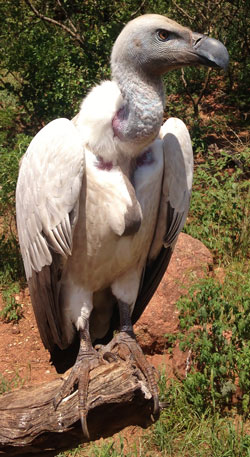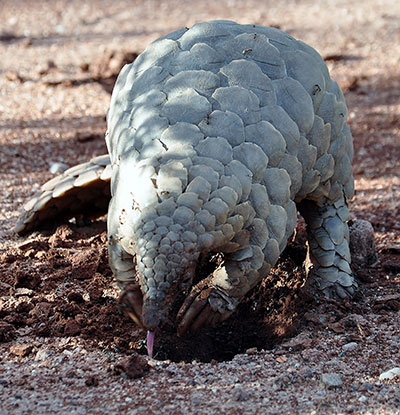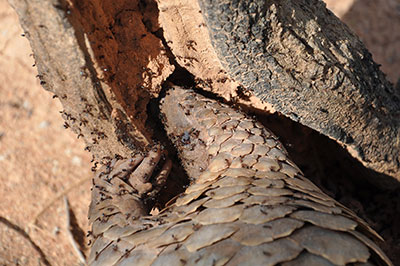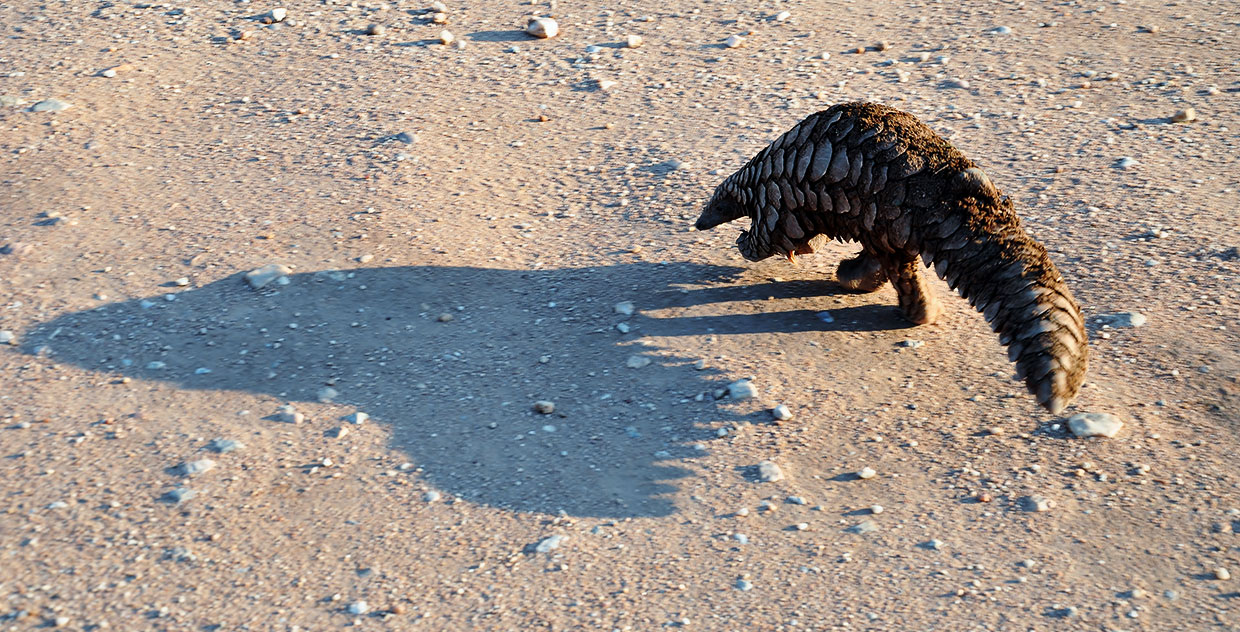by Josh Flatman
The torturous drip…drip of water from my roof into one of the plastic tubs on the floor has ceased for the time-being. Peering through my mosquito net and the gap in the curtains I can see the flashes from distant storms. I am not sure the drips will stay away for long. I am in central Namibia, the 5th least populated country on the planet, home to spectacular scenery and wildlife and what is thought to be the oldest desert in the world. I arrived at the end of the rainy season, the heat of the day often culminating in a frantic shower of lightning and a dumping of rain onto the shrubland. Flowers and grasses spring into action, seizing the opportunity before the long dry winter, producing colourful, thick, dewy carpets in contrast to the orange, cracked earth. It was not quite the weather I had expected for fieldwork in Southern Africa.
I was working at the Rare and Endangered Species Trust (REST), a small organisation that has a rehabilitation and education centre 47km south of Otjiwarongo, with the aim to care for, rehabilitate and release wildlife. REST also aims to carry out research and education on some species which are not often in the spotlight, but are thought to be of particular conservation concern, of which it has coined the phrase, Namibia’s forgotten five (more recently the forgotten five plus one). These are the Cape griffon vulture, dwarf python, African wild dog, Temminck’s ground pangolin or Cape pangolin, Damara dik-dik and the spotted rubber frog. These animals are representative of the entire land ecosystem of Namibia. REST is also home to a number of animals that are not deemed fit for release.
Maria Diekmann, REST’s founder, was originally inspired to help Namibia’s wildlife by the plight of the majestic Cape griffon vulture and the majority of the project’s initial conservation work focussed on this species. The largest bird of its kind in Africa, it is threatened by electrocution from power lines, habitat change and by poisonings both directly and indirectly. More so in the last three years than ever before, elephant and rhino poachers are lacing carcasses with poison to directly target vultures, whose aerial presence, above an animal they have slain, is seen as a clear giveaway to the poacher’s whereabouts, potentially alerting and informing officials in the area. Farmers and ranchers also sometimes use poisons in the carcasses of animals, to target predators, which they believe threaten their stock. The outcome of both is the same, the gregarious nature of vultures results in mass die offs, 50-500 can be poisoned from one carcass. The species is listed as vulnerable with the global population thought to stand at around 8000 birds, but despite Maria and REST’s best efforts, which have included releasing birds from South African populations into Namibia, radio tracking and tagging individuals, it is now classed as extinct as a breeding species in the country. Evidence from Maria’s radio tracking of individuals shows flights of up to 400km into neighbouring countries, with just one poisoned carcass enough to prove fatal, it demonstrates just how difficult a problem this is to tackle.
 In the large aviary built into the side of the mountain on which REST lies in shadow, Nesher, one of the three resident, un-releasable, Capes and the only male, lands a few feet away, his two and a half metre wingspan sending dust and spiralling feathers towards me, as he slows down to steady himself on landing. Nesher was captive bred and despite efforts he is too tame to be released back into the wild. It is hoped he will be instrumental in captive breeding programmes. He looks quizzically at me, his long bald neck craning to see if I am carrying any food. A brighter white than the white-backed vultures they can be confused with and bulkier than their nearest rival in size, the lappet-faced vulture. I am aware I will never have the opportunity to be in such close quarters with these birds again, to admire the industrial bill, the long, thick reptilian toes or to be fixed in the yellow eyes of an animal that has evolved so perfectly to cope with the poisons of the natural world such as anthrax and botulism, but not to such rapid and intense human pressure. It is a tragedy that now no one can see this mighty bird, in the wild, in Namibia.
In the large aviary built into the side of the mountain on which REST lies in shadow, Nesher, one of the three resident, un-releasable, Capes and the only male, lands a few feet away, his two and a half metre wingspan sending dust and spiralling feathers towards me, as he slows down to steady himself on landing. Nesher was captive bred and despite efforts he is too tame to be released back into the wild. It is hoped he will be instrumental in captive breeding programmes. He looks quizzically at me, his long bald neck craning to see if I am carrying any food. A brighter white than the white-backed vultures they can be confused with and bulkier than their nearest rival in size, the lappet-faced vulture. I am aware I will never have the opportunity to be in such close quarters with these birds again, to admire the industrial bill, the long, thick reptilian toes or to be fixed in the yellow eyes of an animal that has evolved so perfectly to cope with the poisons of the natural world such as anthrax and botulism, but not to such rapid and intense human pressure. It is a tragedy that now no one can see this mighty bird, in the wild, in Namibia.
As well as the Cape griffon vultures it is safe to say that Maria’s other passion lies with pangolins. This has much to do with one particular pangolin named Katiti and his mother Roxy. To think of an animal more bizarre would be difficult; it is bipedal, holding its front legs, complete with long claws, close to its body, which is fully covered in scales. It has a tongue that can be longer than its body. The largest species can weigh up to 33kg and measure 140cm long and its closest genetic relation is the carnivora order containing hyenas and wolves. However within these comic complexities and obscurities hides darker facts about this animal; it is particularly vulnerable to electrocution by electric fence, all eight species are threatened with extinction and it is listed by the IUCN as the most illegally trafficked mammal in the world. We might wipe out this curious oddball before we know anything about it.
Roxy was seized from the black market and given to Maria to be rehabilitated and released. Unbeknown to REST staff, Roxy was pregnant and the subsequent birth of a male pup enabled the first footage to be recorded of a Cape pangolin birth. Everything was new at this stage and the first photo in the public domain of a Cape pangolin pup being carried on the back of its mother was also captured by REST. However, after a foraging trip Roxy did not return to her pup and Maria and her staff were forced to raise the animal themselves. That was two and half years ago and on my first meeting with Katiti, it certainly did not look like it had held him back. Almost more surprising than the very nature of a pangolin was the fact that Maria was carrying him around her neck and on her head. Every day Katiti was taken out to forage for up to 5 hours and in order to supply him with enough ants and termites that hadn’t previously been disturbed, it was important to take him to different areas of REST’s land. You could say that it’s unusual to find ants and termites that haven’t been disturbed, as most people tend to call somewhere like Illinois pest control at the first sight of them, especially if they’re in their homes. But as they were sending him to different areas, this shouldn’t be much of a problem. This required carrying him to and from foraging grounds and the most comfortable way for both pangolin and accomplice is either sat on your shoulder with his muscular tail wrapped around your neck or perched on top of your head. I learned it was a good idea to wear a hat if Katiti chose the latter method of transportation.
Pangolins do not generally fare well in captivity, not being able to cope with the stress and the change in environment. However, Katiti is flourishing. He is measured and weighed twice a day and enjoys sleeping for most for it. Upon waking he is taken out to forage. In this way Katiti forages completely naturally, using his strong front claws to dig into ant nests in the hard ground, fishing out its inhabitants with his long tongue. He can visit between 50-150 nests in one session. The number of times he eats, what he eats and a GPS track is recorded by the observer. Very little is known about pangolin behaviour due to their elusive nature, therefore being able to follow Katiti in this way enables not only important data to be collected but provides an insight into the lives of these poorly understood creatures.
 Katiti trundles along, his armoured tail raised parallel to the ground as well as his front limbs, his elephant-like, stump back legs powering him, constantly alert to the vibrations or sounds of ants underground. He stops and the sharp ends of his long, adapted nails flick at the pea sized entrance hole to the ant nest, attempting to breach the rock hard earth. I flinch, imagining the feeling of losing a fingernail, as his powerful limbs are making no headway. But Katiti is undeterred, his claws much stronger than I imagine. He is in, flicking clods of earth around him, then spraying sand as the ground gets softer. His tongue goes to work and so do the ants, swarming all over him. A protective membrane covers his eyes and being heavily scaled helps protect from the bites, but I wonder about his soft underbelly. Sometimes he spends less than a minute at a nest, other times nearer ten, digging deep into the earth and the heart of the nest. Katiti pushes on through the bush, a small battering ram, over and through thick thorn bushes, dead trees and ditches, unaware of the difficulty for his human follower. He is equipped with a tracking device, screwed onto one of his hard scales, in case the vicious, skin-tearing, shirt-ripping African flora is too thick for me and he is lost. Fortunately, he is quite easy to hear ploughing through the undergrowth, even if lost to sight. Occasionally Katiti will flinch into his protective ball, in response to something unseen, unheard, unfelt by me, but clearly a perceived danger. A more primitive defence mechanism surely does not exist than to become an immobile, impenetrable ball. Sadly this has led to the pangolin’s demise, as this may be enough to fool big cats but it makes them an easy target for humans.
Katiti trundles along, his armoured tail raised parallel to the ground as well as his front limbs, his elephant-like, stump back legs powering him, constantly alert to the vibrations or sounds of ants underground. He stops and the sharp ends of his long, adapted nails flick at the pea sized entrance hole to the ant nest, attempting to breach the rock hard earth. I flinch, imagining the feeling of losing a fingernail, as his powerful limbs are making no headway. But Katiti is undeterred, his claws much stronger than I imagine. He is in, flicking clods of earth around him, then spraying sand as the ground gets softer. His tongue goes to work and so do the ants, swarming all over him. A protective membrane covers his eyes and being heavily scaled helps protect from the bites, but I wonder about his soft underbelly. Sometimes he spends less than a minute at a nest, other times nearer ten, digging deep into the earth and the heart of the nest. Katiti pushes on through the bush, a small battering ram, over and through thick thorn bushes, dead trees and ditches, unaware of the difficulty for his human follower. He is equipped with a tracking device, screwed onto one of his hard scales, in case the vicious, skin-tearing, shirt-ripping African flora is too thick for me and he is lost. Fortunately, he is quite easy to hear ploughing through the undergrowth, even if lost to sight. Occasionally Katiti will flinch into his protective ball, in response to something unseen, unheard, unfelt by me, but clearly a perceived danger. A more primitive defence mechanism surely does not exist than to become an immobile, impenetrable ball. Sadly this has led to the pangolin’s demise, as this may be enough to fool big cats but it makes them an easy target for humans.
Although foraging in the cooler part of the day, sometimes it is too hot for Katiti and he will rest on his scaly back with his belly exposed and urinate over himself, wiggling, trying to spread the cooling liquid over him with his forelimbs. It is much the same action when he finds a muddy puddle, he will roll around on his back and shake vigorously, stirring the mud up and covering himself the best he can. It is likely that this benefits his scales and skin by providing protection against parasites and the strong African sun.
 Katiti’s role at REST is not only as a powerful educational tool, to promote awareness among local people and visitors, but also in helping to rehabilitate other pangolins. Due to an increase in demand for pangolin products in both Africa and Asia, REST have received many that have been seized from the black market. Those in good health are released as quickly as possible into protected areas. More often, however, pangolins are received emaciated, stressed and dehydrated and the extra shock of being admitted to a rehabilitation centre is sometimes enough to kill them. Maria has had more success in rehabilitating these animals using Katiti. She believes that Katiti, as he is comfortable in the surroundings, helps to settle his compatriots so they can begin to behave more naturally and build up the strength to be releasable.
Katiti’s role at REST is not only as a powerful educational tool, to promote awareness among local people and visitors, but also in helping to rehabilitate other pangolins. Due to an increase in demand for pangolin products in both Africa and Asia, REST have received many that have been seized from the black market. Those in good health are released as quickly as possible into protected areas. More often, however, pangolins are received emaciated, stressed and dehydrated and the extra shock of being admitted to a rehabilitation centre is sometimes enough to kill them. Maria has had more success in rehabilitating these animals using Katiti. She believes that Katiti, as he is comfortable in the surroundings, helps to settle his compatriots so they can begin to behave more naturally and build up the strength to be releasable.
REST is a small organization run by Maria and her only permanent member of staff, Margareth, trying its best to tackle problems of biodiversity loss in Namibia. Perhaps it is too late for the Cape griffon vulture in the country and an appetite for the pangolins’ skin, scales and meat has thrown all eight species across the globe into steep decline. Pangolin skin is used in the manufacture of boots and other leather items, the meat is consumed as a delicacy as well as imparting perceived health benefits, and the scales are dried and used in traditional medicines to treat a variety of ills from asthma to cancers, even to promote lactation. As populations of the four Asian pangolin species are not able to meet current demand, due to over-hunting, there is evidence to suggest that the resultant high prices are driving the smuggling of African pangolins across continents to meet the shortfall. Perhaps this market is the biggest threat to Katiti and his species, currently classed as vulnerable. Will the four African species go the same way as their Asian cousins (two species listed as endangered, two as critically endangered)?
As for REST, the organisation where I have been able to experience such magical moments with animals I am not likely to ever see again, they are learning things about these creatures that no one else in the world knows. Their passionate, labour intensive, all-consuming, conservation and rehabilitation work provides hope for many African creatures, inspires many children and educates farmers and ranchers on how to treat wildlife. Now the very existence of REST, as if some twisted metaphor for the animals it is trying to save, hangs in the balance. Maria is seeing the organisation that she built from scratch in the African bush, threatened with eviction. Wildlife conservation is often a labour of love, a passionate endeavour that puts personal hardship second to the benefit of species that can’t thank you for doing so. It is a struggle and a fight against people and organisations that choose not to care for conservation and wildlife. REST will continue to fight but if organisations like them lose what will Namibia, Africa and the world lose?
REST are in urgent need of support to continue their work in Namibia. For more information, visit their website: http://www.restafrica.org
Josh Flatman is a graduate from Exeter University with a conservation biology and ecology degree and a masters by research in wildlife disease management. He has participated in turtle conservation in Northern Cyprus, cetacean research in Norway and most recently volunteered in Namibia at REST and at a baboon research project run by ZSL. www.joshflatman.com
All images by Josh Flatman

